- State Board
-
12th Standard
-

Biology
-

Computer Applications
-

Computer Science
-

Business Maths and Statistics
-

Commerce
-

Economics
-

Maths
-

Chemistry
-

Physics
-

Computer Technology
-

History
-

Accountancy
-

Tamil
-

Maths
-

Chemistry
-

Physics
-

Biology
-

Computer Science
-

Business Maths and Statistics
-

Economics
-

Commerce
-

Accountancy
-

History
-

Computer Applications
-

Computer Technology
-

English
12th Standard stateboard question papers & Study material
தமிழ் Subjects
English Subjects
-
-
11th Standard
-

Maths
-

Biology
-

உயிரியல் - தாவரவியல்
-

Economics
-

Physics
-

Chemistry
-

History
-

Business Maths and Statistics
-

Computer Science
-

Accountancy
-

Commerce
-

Computer Applications
-

Computer Technology
-

Tamil
-

Maths
-

Commerce
-

Economics
-

Biology
-

Business Maths and Statistics
-

Accountancy
-

Computer Science
-

Physics
-

Chemistry
-

Computer Applications
-

History
-

Computer Technology
-

Tamil
-

English
11th Standard stateboard question papers & Study material
தமிழ் Subjects
English Subjects
-
-
9th Standard
-

-

-

-

-

-

-

Maths
-

Science
-

Social Science
-

Maths
-

Science
-

Social Science
9th Standard stateboard question papers & Study material
தமிழ் Subjects
English Subjects
-
-
6th Standard
-

Maths
-

Science
-

Social Science
-

Maths
-

Science
-

Social Science
6th Standard stateboard question papers & Study material
தமிழ் Subjects
English Subjects
-
-
10th Standard
-

Maths
-

Science
-

Social Science
-

Tamil
-

Maths
-

Science
-

Social Science
-

English
-

English
10th Standard stateboard question papers & Study material
தமிழ் Subjects
English Subjects
-
-
7th Standard
-

Maths
-

Science
-

Maths
-

Science
-

Social Science
7th Standard stateboard question papers & Study material
தமிழ் Subjects
English Subjects
-
-
8th Standard
-

கணிதம் - old
-

Science
-

Social Science
-

கணிதம்
-

Maths
-

Science
-

Social Science
8th Standard stateboard question papers & Study material
தமிழ் Subjects
English Subjects
-
-
12th Standard
- CBSE Board
-
12th Standard CBSE
-

Biology
-

Physics
-

Chemistry
-

Maths
-

Accountancy
-

Introductory Micro and Macroeconomics
-

Business Studies
-

Economics
-

Computer Science
-

Geography
-

English
-

History
-

Indian Society
-

Physical Education
-

Sociology
-

Tamil
-

Bio Technology
-

Engineering Graphics
-

Entrepreneurship
-

Hindi Core
-

Hindi Elective
-

Home Science
-

Legal Studies
-

Political Science
-

Psychology
12th Standard CBSE Subject Question Paper & Study Material
-
-
11th Standard CBSE
-

Mathematics
-

Chemistry
-

Biology
-

Physics
-

Business Studies
-

Accountancy
-

Economics
-

Computer Science
-

Bio Technology
-

English
-

Enterprenership
-

Geography
-

Hindi
-

History
-

Home Science
-

Physical Education
-

Political Science
-

Psychology
-

Sociology
-

Applied Mathematics
11th Standard CBSE Subject Question Paper & Study Material
-
- 10th Standard CBSE
-
9th Standard CBSE
-

Mathematics
-

Social Science
-

Science
-

English
-

Hindi
9th Standard CBSE Subject Question Paper & Study Material
-
-
8th Standard CBSE
-

Science
-

Social Science
-

Mathematics
-

English
8th Standard CBSE Subject Question Paper & Study Material
-
-
7th Standard CBSE
-

Mathematics
-

Science
-

Social Science
-

English
7th Standard CBSE Subject Question Paper & Study Material
-
-
6th Standard CBSE
-

Mathematics
-

Science
-

Social Science
-

English
6th Standard CBSE Subject Question Paper & Study Material
-
-
12th Standard CBSE
- Free Online Test
- News
- Study Materials
-
Students
-

Stateboard Tamil Nadu
-

CBSE Board
-

Free Online Tests
-

Educational News
-

Scholarships
-

Entrance Exams India
-

Video Materials
Study Materials , News and Scholarships
-
-
Students

6th Standard English Medium Maths Subject Term 3 Book Back 5 Mark Questions with Solution Part - I Question Bank Software Jun-18 , 2021
QB365 provides detailed and simple solution for every book back questions in class 6 Maths subject.It will helps to get more idea about question pattern in every book back questions with solution.
6th Standard English Medium Maths Subject Term 3 Book Back 5 Mark Questions with Solution Part - I
6th Standard
-
Reg.No. :
Maths
Time :
01:00:00 Hrs
Total Marks :
100
-
Convert mixed fractions into improper fractions and vice versa:
\(i)\ 3{7\over 18}\)
\(ii)\ {99\over7}\)
\(iii)\ {47\over6}\)
\(iv)\ 12{1\over9}\) -
Divide the following :
\(i) \ {3\over7}\div4\)
\(ii)\ {4\over3}\div{5\over9}\)
\(iii)\ 4{1\over5}\div3{3\over 4}\)
\(iv)\ 9{2\over3}\div1{2\over3}\) -
A painter painted \(3\over8\) of the wall of which one third is painted in yellow colour. What fraction is the yellow colour of the entire wall?
-
Look at the picture and answer the following questions:
i) What is the distance from School to Library via Bus stop?
ii) What is the distance between School and Library via Hospital?
iii) Which is the shortest distance between (i) and (ii)?
iv) The distance between School and Hospital is ________ times the distance between School and Bus stop. -
Using the given fractions \(\cfrac { 1 }{ 5 } ,\cfrac { 1 }{ 6 } ,\cfrac { 1 }{ 10 } ,\cfrac { 1 }{ 15 } ,\cfrac { 2 }{ 15 } ,\cfrac { 4 }{ 15 } ,\cfrac { 1 }{ 30 } ,\cfrac { 7 }{ 30 } \) and \(\cfrac { 9 }{ 36 } \) fiIl in the missing ones in the given -3 \(\times\) 3 square in such a way that the addition of fractions through rows, columns and diagonals give the same total
\(\cfrac { 1 }{ 30 } \) \(\cfrac { 2 }{ 15 } \) -
Complete the table using the following hints:
C1: the first non-negative integer.
C3: the opposite to the second negative integer.
C5: the additive identity in whole numbers.
C6: the successor of the integer in C2.
C8: the predecessor of the integer in C7.
C9: the opposite to the integer in C5
-
Answer the following questions from the number line given below
i) Which integer is greater : G or K ? Why ?
ii) Find the integer that represents C.
iii) How many integers are there between G and H?
iv) Find the pairs of letters which are opposite of a number.
v) Say True or False : 6 units to the left of D is −6. -
Ask your parents / grandparents about the depth at which the various types of vegetables (seeds) should be planted, for their better and efficient growth. For the same, draw a number line indicating the depth of various vegetable seeds. (draw the planting chart!)
-
The table given below contains some measures of the rectangle. Find the unknown values
S. No Length Breadth Perimeter Area i) 5 cm 8 cm ? ? ii) 13 cm ? 54cm ? iii) ? 15 cm 60 cm ? iv) 10 m ? ? 120 square metre v) 4 feet ? 20 square feet -
A closed shape has 20 equal sides and one of its sides is 3 cm. Find its perimeter.
-
The length of a rectangle is three times its breadth. If its perimeter is 64 cm, find the sides of the rectangle
-
Draw a square B whose side is twice of the square A. Calculate the perimeters of the squares A and B.
-
Two plots have the same perimeter. One is a square of side 10 m and another is a rectangle of breadth 8 m. Which plot has the greater area and by how much?
-
Find the approximate area of the flower in the given square grid.
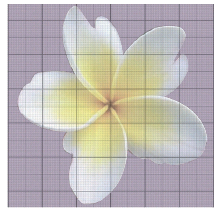
-
Mark the base and height of the following right angled triangles
(i)
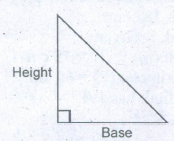
(ii)
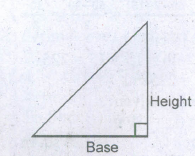
(iii)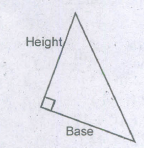
(iv)
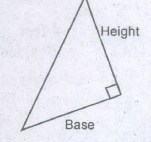
(v)
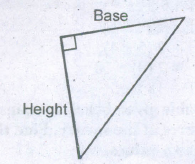
(vi)
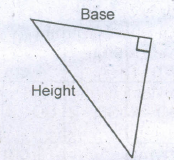
-
From all possible shapes of perimeter 80 cm with 9 identical squares, each of side 4 cm.
-
Join six identical squares so that atleast one side of a square fits exactly with any other side of the square and have reflection symmetry (any three ways).
-
Find the line of symmetry and the order of rotational symmetry of the given regular polygons and complete the following table and answer the questions given below
Shape Equilateral triangle
Square
Regular pentagon
Regular hexagon
Regular octagon
Number of lines of symmetry Order of rotational symmetry i) A regular polygon of 10 sides will have ______ lines of symmetry.
ii) If a regular polygon has 10 lines of symmetry, then its order of rotational symmetry is _______
iii) A regular polygon of 'n' sides has _______ lines of symmetry and the order of rotational symmetry is _______. -
Find, the order of rotational symmetry by fixing the relevant shape in different ways.
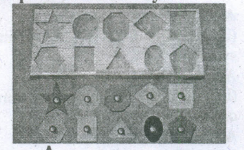
-
Follow the given instructions to fill your name in the OMR sheet.
The name should be written in capital letters from left to right.
One alphabet is to be entered in each box.
If any empty boxes are there at the end they should be left blank.
Ballpoint pen is to be used for shading the bubbles for the corresponding alphabets.
5 Marks
20 x 5 = 100






 6th Standard Maths Syllabus
6th Standard Maths Syllabus 

Reviews & Comments about 6th Standard English Medium Maths Subject Term 3 Book Back 5 Mark Questions with Solution Part - I
Write your Comment